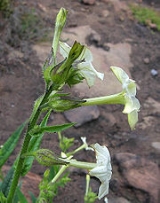
Nicotiana quadrivalvis
Encyclopedia
Nicotiana quadrivalvis is a species of wild tobacco
known by the common name Indian tobacco. It is native to the western United States, where it grows in many types of habitat. It is a bushy, sprawling annual herb growing up to two meters in maximum height. The lower leaf blades are up to 15 centimeters long and are borne on short petioles
, the upper smaller and sessile on the stem. The inflorescence
is an array of several white, greenish, or purple-tinged flowers with tubular throats up to 5 centimeters long. The base of each is enclosed in a ridged calyx of sepal
s. The flower face may be 5 centimeters wide. The fruit is a capsule up to 2 centimeters in length.
living on the west coast of North America, in particular southern Oregon
and northern California
, and along the middle Columbia River
. Individually owned plots of tobacco plants were seeded with the previous year's seed capsules, tilled and weeded and fertilized in the fall by mixing in rotten wood after the harvest.
Further north, the Haida, Tlingit and probably Tsimshian
cultivated a related but now extinct variety of tobacco in a similar manner. The original seeds must have been acquired from afar, as tobacco was not native to the northern Northwest Coast. Myths
reflecting this describe the supernatural original acquisition of the seeds.
Nicotiana
Nicotiana is a genus of herbs and shrubs of the nightshade family indigenous to North and South America, Australia, south west Africa and the South Pacific. Various Nicotiana species, commonly referred to as tobacco plants, are cultivated and grown to produce tobacco. Of all Nicotiana species,...
known by the common name Indian tobacco. It is native to the western United States, where it grows in many types of habitat. It is a bushy, sprawling annual herb growing up to two meters in maximum height. The lower leaf blades are up to 15 centimeters long and are borne on short petioles
Petiole (botany)
In botany, the petiole is the stalk attaching the leaf blade to the stem. The petiole usually has the same internal structure as the stem. Outgrowths appearing on each side of the petiole are called stipules. Leaves lacking a petiole are called sessile, or clasping when they partly surround the...
, the upper smaller and sessile on the stem. The inflorescence
Inflorescence
An inflorescence is a group or cluster of flowers arranged on a stem that is composed of a main branch or a complicated arrangement of branches. Strictly, it is the part of the shoot of seed plants where flowers are formed and which is accordingly modified...
is an array of several white, greenish, or purple-tinged flowers with tubular throats up to 5 centimeters long. The base of each is enclosed in a ridged calyx of sepal
Sepal
A sepal is a part of the flower of angiosperms . Collectively the sepals form the calyx, which is the outermost whorl of parts that form a flower. Usually green, sepals have the typical function of protecting the petals when the flower is in bud...
s. The flower face may be 5 centimeters wide. The fruit is a capsule up to 2 centimeters in length.
Cultivation
N. quadrivalvis was cultivated by indigenous peoplesIndigenous peoples
Indigenous peoples are ethnic groups that are defined as indigenous according to one of the various definitions of the term, there is no universally accepted definition but most of which carry connotations of being the "original inhabitants" of a territory....
living on the west coast of North America, in particular southern Oregon
Oregon
Oregon is a state in the Pacific Northwest region of the United States. It is located on the Pacific coast, with Washington to the north, California to the south, Nevada on the southeast and Idaho to the east. The Columbia and Snake rivers delineate much of Oregon's northern and eastern...
and northern California
California
California is a state located on the West Coast of the United States. It is by far the most populous U.S. state, and the third-largest by land area...
, and along the middle Columbia River
Columbia River
The Columbia River is the largest river in the Pacific Northwest region of North America. The river rises in the Rocky Mountains of British Columbia, Canada, flows northwest and then south into the U.S. state of Washington, then turns west to form most of the border between Washington and the state...
. Individually owned plots of tobacco plants were seeded with the previous year's seed capsules, tilled and weeded and fertilized in the fall by mixing in rotten wood after the harvest.
Further north, the Haida, Tlingit and probably Tsimshian
Tsimshian
The Tsimshian are an indigenous people of the Pacific Northwest Coast. Tsimshian translates to Inside the Skeena River. Their communities are in British Columbia and Alaska, around Terrace and Prince Rupert and the southernmost corner of Alaska on Annette Island. There are approximately 10,000...
cultivated a related but now extinct variety of tobacco in a similar manner. The original seeds must have been acquired from afar, as tobacco was not native to the northern Northwest Coast. Myths
Native American mythology
Native American mythology is the body of traditional narratives associated with Native American religion from a mythographical perspective. Native American belief systems include many sacred narratives. Such spiritual stories are deeply based in Nature and are rich with the symbolism of seasons,...
reflecting this describe the supernatural original acquisition of the seeds.

